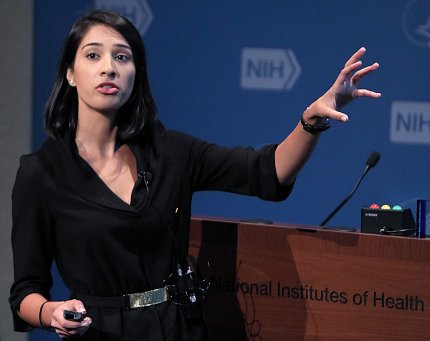CC Researchers Begin to Unravel Mysteries of Liver Diseases

Photo: Chia-Chi Charlie Chang
Liver diseases such as hepatitis B and C affect millions of people, explained Dr. Theo Heller during a recent Clinical Center Grand Rounds lecture in Lipsett Amphitheater.
“The impact on society is significant,” said Heller, a senior investigator and chief of the NIDDK Liver Diseases Branch’s translational hepatology section.
The liver’s responsibilities include making proteins that are essential for blood clotting and filtering blood that comes from the digestive tract, removing toxins from the bloodstream and storing energy.
At the Clinical Center, Heller is studying why liver diseases progress and how progression varies in individual patients. Patients with hepatitis C, for instance, first develop inflammation, then cirrhosis, a condition where scar tissue replaces normal liver tissue and, finally, end-stage liver disease with or without liver cancer. HIV, alcohol dependence or diabetes can accelerate liver disease progression. The exact mechanisms of progression aren’t clear.
“We’re not understanding what came into the liver and what might affect the development of liver disease,” he noted.
The portal vein might hold clues. It moves blood from the gastrointestinal tract, gallbladder, pancreas and spleen to the liver. Getting to the vein is difficult because of its location. It’s one of two places in the body—the other is the brain—where radiologists cannot thread a catheter by traditional methods. Heller likened the portal vein to the dark side of the moon, both of which are largely unexplored.
In one clinical trial at the CC, his lab studied the portal vein in 29 patients with hepatitis C. Some patients had portal hypertension. The researchers took liver tissue and portal blood samples and studied patients’ inflammation, immune system, microbiome and metabolism. The patients were also enrolled in a study that treated their hepatitis C.
“We were analyzing the data in real time and we understood we had a problem,” Heller explained. “These patients had hepatitis C, portal hypertension, fibrosis and inflammation. How do you tease apart all these different things?”

Photo: Chia-Chi Charlie Chang
A postdoctoral fellow in his section, Dr. Rabab Ali, suggested they run the exact same tests once all the patients cleared their hepatitis C infection. Once the patients recovered, Heller and Ali invited them back for additional testing.
Twenty-four patients from the first clinical trial returned. After the study’s completion, Heller’s lab had much data to analyze. They began searching for markers that predict liver disease.
Ali said lipid and bile acid metabolism change over the progression of the disease.
Patients with liver fibrosis had higher levels of free fatty acids in their portal blood. Ali speculated that this may be for many reasons, including as a source of energy for the “metabolically stressed liver” or for certain types of immune cells. Some macrophages, for example, use fatty acids.
Patients with advanced liver disease have abnormal bile acid profiles compared to a person without liver disease. Bile is produced by the liver and helps break down fats and water-soluble vitamins. Once the fats and vitamins are broken down, the digestive system takes them in. There are also bacteria found in the gut microbiome that play a role in bile acid metabolism, she said.
There are receptors in the liver that bind to different types of bile acids. The receptors behave differently in patients with advanced liver disease. “These receptors are being used as targets for drugs,” she explained.
The research taking place at the CC couldn’t happen anywhere else, the speakers agreed. “We have a unique environment at NIH,” Heller said. “We don’t just have an opportunity to take the road. We can lay down the road.”
